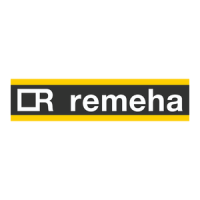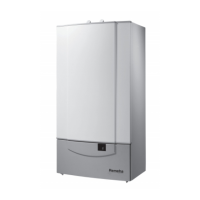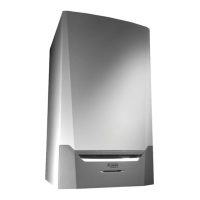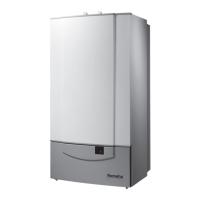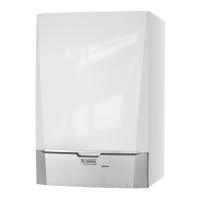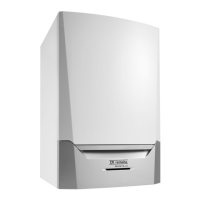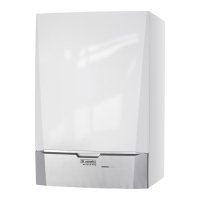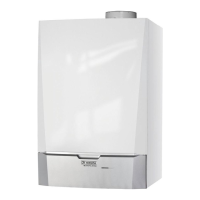What to do if REMEHA Boiler water pressure is too low?
- CChristine HernandezAug 19, 2025
If the water pressure in your REMEHA boiler is too low, ensure that you check the water pressure and fill the boiler and the installation with water.
What to do if REMEHA Boiler water pressure is too low?
If the water pressure in your REMEHA boiler is too low, ensure that you check the water pressure and fill the boiler and the installation with water.
How to fix REMEHA Quinta Pro Boiler maximum flow temperature exceeded?
If the maximum flow temperature is exceeded in your REMEHA boiler, it could be due to no flow or insufficient flow. Check the flow (direction, pump, valves) and reasons for the heat demand.
What to do if REMEHA Boiler gas pressure is too low?
If the gas pressure is too low in your REMEHA boiler, it might be due to insufficient flow or an incorrect setting on the gas pressure switch (Gps) on the SCU PCB. Check that the gas valve is fully opened, check the gas supply pressure, check whether the Gps has been correctly fitted, and replace the Gps switch if necessary.
What causes REMEHA Quinta Pro Boiler to have five failed burner starts?
Five failed burner starts in your REMEHA boiler can be caused by no ignition spark. To solve this, check the cabling of the ignition transformer, the ionization/ignition electrode, breakdown to earth, the condition of the burner cover, the earthing, or a defective control SU PCB.
What to do if REMEHA Boiler flow temperature sensor is short circuited?
If the flow temperature sensor is short-circuited in your REMEHA boiler, it may be due to a bad connection or the sensor not being connected properly. Check that the sensor has been fitted properly, ensure the sensors are operating correctly, and replace the sensor if necessary.
Why does REMEHA Quinta Pro have maximum increase of the flow temperature exceeded?
If the maximum increase of the flow temperature has been exceeded in your REMEHA boiler, it could be due to no flow or insufficient flow, or a sensor error. Check the flow (direction, pump, valves), the water pressure, that the sensors are operating correctly, that the sensor has been fitted properly, and the cleanliness of the heat exchanger.
What causes REMEHA Boiler temperature of heat exchanger to be too high?
If the temperature of the heat exchanger in your REMEHA boiler is too high, it could be due to a bad connection, the sensor not being connected correctly, or no circulation. Check that the sensors are operating correctly, that the sensor has been fitted properly. If necessary, replace the sensor. Vent the air from the CH system, check the circulation (direction, pump, valves), the water pressure and the cleanliness of the heat exchanger. Also, if present, check the boiler type parameter setting.
What causes REMEHA Boiler temperature of heat exchanger to be too low?
If the temperature of the heat exchanger in your REMEHA boiler is too low, it could be due to a bad connection, the sensor not being connected correctly, or no circulation. Check that the sensors are operating correctly, and that the sensor has been fitted properly. If necessary, replace the sensor. Vent the air from the CH system, check the circulation (direction, pump, valves), the water pressure, and the cleanliness of the heat exchanger. If present, check the boiler type parameter setting.
What to do if REMEHA Quinta Pro Boiler shows communication error with the SCU PCB?
If your REMEHA boiler shows a communication error with the SCU PCB, it may be due to a poor connection with the BUS or the SCU PCB not being present in the boiler. Check the wiring and carry out automatic detection.
What causes REMEHA Quinta Pro fan operation error?
A fan operation error in your REMEHA boiler could stem from a bad connection or a defective fan. Ensure adequate draw on the chimney connection and replace the fan if necessary.
Detailed safety instructions for installers and end users regarding gas and flue gases.
Guidance on appliance use, installation, maintenance, and general safety warnings.
Provides comprehensive data on output, efficiency, gas, water, and electrical parameters.
Illustrates boiler dimensions and identifies all connection points for installation.
Presents the detailed electrical diagram and component identification.
States installer qualifications and regulatory adherence requirements.
Details rinsing the system, connecting heating circuits, expansion vessels, and condensate pipes.
Provides instructions and warnings for connecting the gas supply.
Explains classification, outlets, materials, and lengths for air/flue gas systems.
Details control unit connections, mains supply, and general recommendations.
Instructions for checking gas inlet pressure and connections.
Outlines the sequence for starting the boiler, including checks and a venting cycle.
Covers adaptation to different gas types and setting the gas/air ratio for optimal combustion.
Details routine checks like water pressure, ionisation current, combustion, and connections.
Explains how errors are displayed and lists common error codes and their causes/solutions.
Describes blocking codes and how the boiler attempts to restart.
Explains when the boiler enters lockout mode and how error codes are displayed.
| Model | Quinta Pro |
|---|---|
| Category | Boiler |
| Fuel Type | Natural Gas / LPG |
| Installation Type | Wall-mounted |
| Boiler Type | Condensing |
| Emission Class | Class 5 (Low NOx) |
